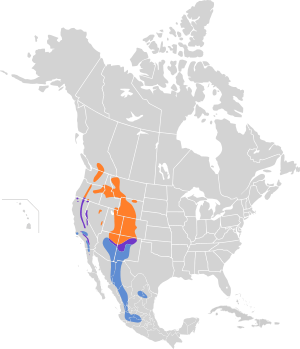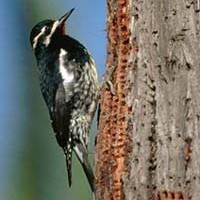Williamson's sapsucker facts for kids
Quick facts for kids Williamson's sapsucker |
|
|---|---|
 |
|
| Male | |
| Conservation status | |
| Scientific classification | |
| Genus: |
Sphyrapicus
|
| Species: |
thyroideus
|
 |
|
The Williamson's sapsucker (Sphyrapicus thyroideus) is a medium-sized woodpecker. It belongs to a group of birds called sapsuckers. These birds are known for drilling small holes in trees to drink the sweet sap.
Contents
Where Does the Williamson's Sapsucker Live?
These sapsuckers live in open forests across western North America. You can find them from northern Mexico all the way up to British Columbia in Canada. They especially like forests with ponderosa pine, Douglas-fir, and grand fir trees.
Some Williamson's sapsuckers stay in one place all year. Others travel south for the winter, sometimes flying as far as central Mexico. When they migrate, they often fly in small groups.
What Does the Williamson's Sapsucker Look Like?
Williamson's sapsuckers have very different looks for males and females. This is called sexual dimorphism. For a long time, people even thought they were different species!
Male Sapsuckers
Adult males are mostly shiny black on their head, back, sides, and tail. They have a white stripe behind each eye. Another white stripe goes across each side of their head. Their chin is red, and their belly is a bright yellow. Their wings are black with large white patches.
Female Sapsuckers
Female Williamson's sapsuckers look completely different. They are mainly black with a pale yellow chest. Their head is brownish with black streaks. Their back, chest, and sides have fine black stripes. When the female was first discovered, it was called the black-breasted woodpecker.
How Big Are They?
- Length: About 8.3 to 9.8 inches (21 to 25 cm)
- Weight: Around 1.6 to 1.9 ounces (44 to 55 grams)
- Wingspan: About 17 inches (43 cm)
Life and Habits of the Williamson's Sapsucker
These birds are busy! They dig a new nesting hole in a tree every year. Sometimes, they even use the same tree for their new nest.
What Do They Eat?
Williamson's sapsuckers mostly feed on tree sap, especially from conifer trees. But during the nesting season, insects are their main food. When it's not breeding time, they also enjoy eating berries.
Communication
These sapsuckers use drumming sounds to mark their territory. It's like saying, "This is my space!"
Why Are They Important?
Williamson's sapsuckers play a role in their forest homes. They create sap wells that other animals, like hummingbirds, can also use for food.
Protecting the Williamson's Sapsucker
Sadly, the number of Williamson's sapsuckers might be going down in some areas. This is because their forest homes are being lost. For example, in south-central British Columbia, less than 500 of these birds breed. Their habitat is disappearing quickly due to logging. Because of this, the species was listed as endangered in Canada in 2005.
How Did It Get Its Name?
The Williamson's sapsucker was named after Lieutenant Robert S. Williamson. He led a surveying trip that found the first male sapsucker. His team was looking for the best way to build a railway to the Pacific Ocean.
Types of Williamson's Sapsuckers
There are two main types, or subspecies, of Williamson's sapsuckers:
- Sphyrapicus thyroideus nataliae (Malherbe, 1854)
- Sphyrapicus thyroideus thyroideus (Cassin, 1852)
A Mix-Up in History
In the 1800s, scientists thought male and female Williamson's sapsuckers were different species. The female was first described in 1852. The male was described later in 1857. It wasn't until 1873 that Henry Henshaw figured out they were the same species. This was also written about in Robert Ridgway's book, 'The Birds of North and Middle America, Part 6' (1914).
See also
 In Spanish: Chupasavia oscuro para niños
In Spanish: Chupasavia oscuro para niños



